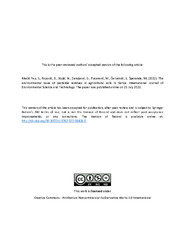Приказ основних података о документу
The environmental issue of pesticide residues in agricultural soils in Serbia
| dc.creator | Medić-Pap, Slađana | |
| dc.creator | Popović, Brigita | |
| dc.creator | Stojić, Nataša | |
| dc.creator | Danojević, Dario | |
| dc.creator | Pucarević, Mira | |
| dc.creator | Červenski, Janko | |
| dc.creator | Šperanda, Marcela | |
| dc.date.accessioned | 2022-07-27T09:53:03Z | |
| dc.date.available | 2023-07-25T09:49:30Z | |
| dc.date.issued | 2022 | |
| dc.identifier.issn | 1735-1472 | |
| dc.identifier.issn | 1735-2630 | |
| dc.identifier.uri | http://fiver.ifvcns.rs/handle/123456789/2937 | |
| dc.description.abstract | Widespread use of pesticides in intensive agriculture indicates the need for permanent monitoring of their residues in soil. For this purpose, a total of 22 evenly distributed sampling points of arable land were chosen in the sampling area in Serbia. Soils were divided into groups according to the previous crop (pepper, vegetables, maize, wheat and soybean). Soil properties and residues of 68 pesticides, of which 22 herbicides, 25 insecticides and 21 fungicides, were analysed in the collected soil samples. The obtained data confirm the heterogeneity of soil samples regarding their organic matter content (1.41–3.39%) and pH value (pH 4.27–8.08). The average number of active ingredients detected per type of previous crop was 1–2 herbicides, 14–16 insecticides, and 3–4 fungicides, while the residues of 3 herbicides, 20 insecticides and 9 fungicides were found in total. Insecticides with mainly organochlorine compounds represented the majority of the detected active ingredients. Although rapid degradability of sulfonylurea herbicides is a well-known fact, the residues of nicosulfuron, ranging from 0.15 to 1.99 μg/kg, were found in three soil samples where maize was grown as a previous crop. Furthermore, triazoles prothioconazole (0.08 ± 0.11 μg/kg), tebuconazole (0.10 ± 0.24 μg/kg) and epoxyconazole (0.13 ± 0.42 μg/kg) were detected in 36%, 18% and 14% soil samples, respectively, while difenoconazole and flusilazole were detected in only one sample. Soil pH value mostly correlated with pesticides. The levels of pesticides detected in agricultural soils should be monitored further, especially in terms of environmental risks posed by their transfer to groundwater and surface waters. | sr |
| dc.language.iso | en | sr |
| dc.publisher | Springer | sr |
| dc.relation | Interreg IPA Crossborder project IMPACT ENVI HR-RS 182 | sr |
| dc.relation | info:eu-repo/grantAgreement/MESTD/inst-2020/200032/RS// | sr |
| dc.rights | embargoedAccess | sr |
| dc.rights.uri | https://creativecommons.org/licenses/by-nc-nd/4.0/ | |
| dc.source | International Journal of Environmental Science and Technology | sr |
| dc.subject | crops | sr |
| dc.subject | nicosulfuron | sr |
| dc.subject | organochlorine compounds | sr |
| dc.subject | triazole | sr |
| dc.subject | vegetables | sr |
| dc.subject | pesticides | sr |
| dc.subject | pesticide residues | sr |
| dc.subject | agricultural soils | sr |
| dc.subject | Serbia | sr |
| dc.title | The environmental issue of pesticide residues in agricultural soils in Serbia | sr |
| dc.type | article | sr |
| dc.rights.license | BY-NC-ND | sr |
| dc.citation.rank | M22 | |
| dc.description.other | This is the peer-reviewed version of the published article [http://fiver.ifvcns.rs/handle/123456789/2936] available in this repository from 25 July 2023 according to the publisher's policy. | |
| dc.identifier.doi | 10.1007/s13762-022-04424-0 | |
| dc.identifier.fulltext | http://fiver.ifvcns.rs/bitstream/id/8210/bitstream_8210.pdf | |
| dc.identifier.scopus | 2-s2.0-85134641943 | |
| dc.identifier.wos | 00082970840000 | |
| dc.type.version | acceptedVersion | sr |


